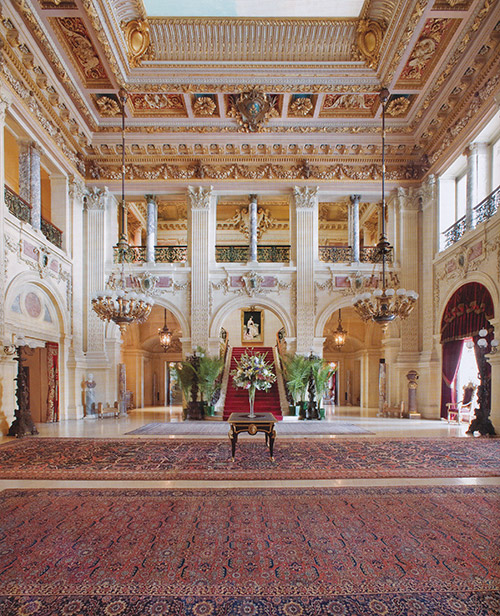Newport has many grand homes, but there is none grander here (or really anywhere in America) than The Breakers. It is (ironically) called a “cottage,” not because it is small but because it was used for only the summer. The Breakers was designed by Richard Morris Hunt, one of the greatest American architects of the late 19th century, in 1895 for Cornelius Vanderbilt II. The Breakers, which resembles a Roman palazzo, is widely considered a masterpiece (and is often identified as the very archetype) of American Renaissance Revival style architecture.
Located on Ochre Point Avenue, this immense and imposing structure is 138,000 square feet in area and sits on 13 acres overlooking the sea. Designed in the Italianate Palazzo style, the house has more than 70 rooms. This house was built following the completion of the Marble House on Bellevue Avenue for Cornelius’s younger brother William K. Vanderbilt; one cannot help but believe there may have been a touch of sibling “one-upmanship” in the desire to create an even grander home than Marble House, also by Hunt.
The Breakers one sees today is a great limestone edifice built on the site of a large wooden Victorian-style house of the same name designed by Peabody & Sterns tobacco magnate Pierre Lorillard IV. The site is magnificently situated overlooking the ocean and rock outcroppings that gave the original structure its name. The original Breakers was purchased by Vanderbilt in 1885 and used by the family until a great fire destroyed the building in 1892. The structure that exists today was designed and built in just two years, which is amazing when one considers its size and richness of construction. The home was used exclusively by the Vanderbilt family until 1948, when Cornelius’ daughter, the Countess Széchényi, opened the house to tours for the benefit of the newly-formed Preservation Society of Newport County. This same organization purchased the building and operates it as one of the busiest tourist attractions in all of New England, drawing more than 400,000 visitors annually. Among the most notable features of the building is the Great Hall, an extraordinary central living area, designed to look like an open area courtyard of a Genovese Palazzo. This amazing space is precisely 50 feet wide by 50 feet long by 50 feet high.
 Great Hall of The Breakers Mansion Cover Art of The Newport Mansions
Great Hall of The Breakers Mansion Cover Art of The Newport Mansions
The great houses of Newport were built for display but also for the purpose of gracious entertainment. They are never more in alignment with their reason for being than when they are filled with gentlemen in evening attire and ladies in beautiful gowns dancing to a live orchestra. This past weekend, for the first time in perhaps many years, The Breakers Great Hall was the setting for a white tie gala dinner and ball to celebrate the Hope Funds for Cancer Research Awards of Excellence. Among the number of Nobel Prize winners and acclaimed scientists invited was James D. Watson, one of the discoverers of DNA. The sold-out event was characterized by long tables, gentlemen dressed in white tie, and ladies in ball gowns, which is how most formal parties were conducted before World War I. Concluding the evening’s speaking program, Leah Cann (chair of the Hope Funds Executive Committee) noted the party was probably very much like the ones that occurred in the house during the historic Vanderbilt era.
The Breakers was truly magnificent and looked all the better for being populated with people who appeared as if they had stepped through a time portal from another century. This grand evening was like time traveling back to a place of extraordinary elegance for many of the guests. Perhaps that is one of the most important functions of the great mansions in the Preservation Society of Newport County portfolio: their ability to help visitors understand in some small way what life was like for people of another era. It makes great homes like The Breakers well worth a regular visit—whether it be for an elegant party or just for a tour.
Looking to remodel your home? Let’s connect.
Join the Architectural Forum to stay up-to-date with architectural news from Rhode Island and abroad.

